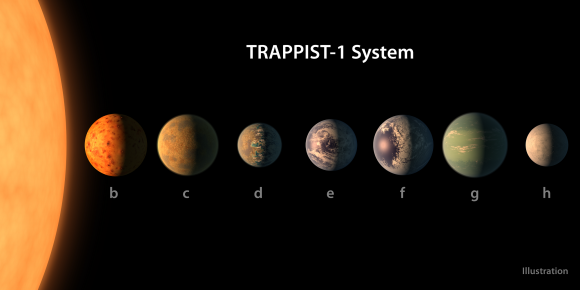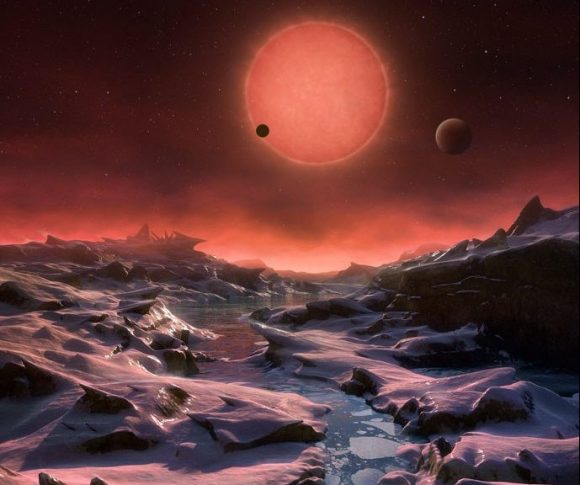Back in February of 2017, NASA announced the discovery of a seven-planet system orbiting a nearby star. This system, known as TRAPPIST-1, is of particular interest to astronomers because of the nature and orbits of the planets. Not only are all seven planets terrestrial in nature (i.e. rocky), but three of the seven have been confirmed to be within the star’s habitable zone (aka. “Goldilocks Zone”).
But beyond the chance that some of these planets could be inhabited, there is also the possibility that their proximity to each other could allow for life to be transferred between them. That is the possibility that a team of scientists from the University of Chicago sought to address in a new study. In the end, they concluded that bacteria and single-celled organisms could be hopping from planet to planet.
This study, titled “Fast Litho-panspermia in the Habitable Zone of the TRAPPIST-1 System“, was recently published in the Astrophysical Journal Letters. For the sake of seeing if life could be distributed within this star system (aka. litho-panspermia), Krijt and his fellow UChicago scientists ran simulations that showed that this process could happen 4 to 5 times faster than it would in our Solar System.

As Sebastiaan Krijt – a postdoctoral scholar at UChicago and the lead author on the study – said in a University press release:
“Frequent material exchange between adjacent planets in the tightly packed TRAPPIST-1 system appears likely. If any of those materials contained life, it’s possible they could inoculate another planet with life.”
For the sake of their study, the team considered that any transfers of life would likely involve asteroids or comets striking planets within the star’s habitable zone (HZ) and then transferring the resulting material to other planets. They then simulated the trajectories that the ejecta would take, and tested to see if it would have the necessary speed to get out of orbit (escape velocity) and be captured by a neighboring planet’s gravity.
In the end, they determined that roughly 10% of the material that would be capable of transferring life would have the velocity necessary to not only achieve escape velocity. This covered the pieces of ejecta that would be large enough to endure irradiation and the heat of re-entry. What’s more, they found that this material would be able to reach another HZ planet with periods ranging from 10 to 100 years.

For over a century, scientists have considered the possibility that life may be distributed throughout our Universe by meteoroids, asteroids, comets, and planetoids. Similarly, multiple studies have been conducted to see if the building blocks of life could have come to Earth (and been distributed throughout the Solar System) in the same way.
Every year, an estimated 36,287 metric tons (40,000 tons) of space debris falls to Earth, and material that has been ejected from our planet is floating around out in space as well. And we know for a fact that Earth and Mars have exchanged material on several occasions, where Martian ejecta kicked up by asteroids and comets was thrown into space and eventually collided with our planet.
As such, studies like this can help us to understand how life came to be in our Solar System. At the same time, they can illustrate how in other star systems, the process may be far more intense. As Fred Ciesla – a professor of geophysical sciences at UChicago and a co-author of the paper – explained:
“Given that tightly packed planetary systems are being detected more frequently, this research will make us rethink what we expect to find in terms of habitable planets and the transfer of life—not only in the TRAPPIST-1 system, but elsewhere. We should be thinking in terms of systems of planets as a whole, and how they interact, rather than in terms of individual planets.”

And with all the exoplanets discoveries made of late – which can only be described as explosive – opportunities for research are similarly exploding. In total, some 3,483 exoplanets have been confirmed so far, with an additional 4,496 candidates awaiting confirmation. Of the confirmed planets, 581 have been found to exist within multi-planet systems (like TRAPPIST-1), each of which present the possibility of litho-panspermia.
By studying more and more in the way of distant planets, we can reach beyond our own Solar System to see how planets evolve, interact, and how life can come to exist on them. And someday, we may actually be able to study them up close! One can only imagine what we may find…
Further Reading: University of Chicago, Astrophysical Journal Letters

